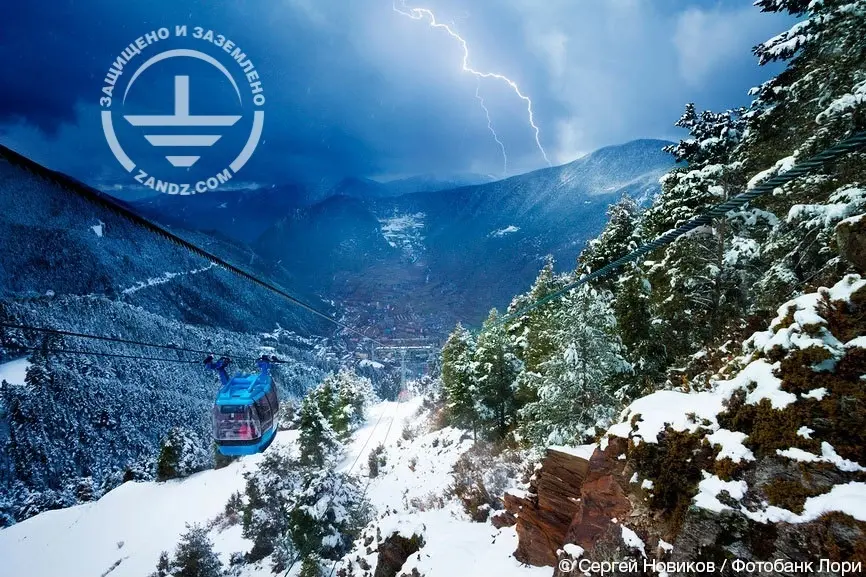
In the 21st century, everybody knows that the Earth is round, even those at the Central TV. But it seems that many people don't even know that the Earth surface is not always plain. Well, at least we can think this is what the authors of the lightning protection standards believe in. These documents do not consider any mountains or gorges. The surface is flat and that's it. When two centuries ago, the builders began to construct a church in my town located in the Moscow Region, they chose the highest point for it, i.e. the Tserkovka Mount on the lake shore. They knew what they were doing: the closer the church to the sky, the closer it is to God. Although it is also closer to thunderclouds. Certainly, such closeness means something, but the lightning protection standards do not say a word about that. The ground surface is considered to be flat in all documents. There is something to think about and, if necessary, evaluate the terrain effect on the lightning protection. That's worth it because lightning protection is quite expensive.
1. Gorge effect
Let's start with an easier and clearer point. There's no doubt about it. A gorge hides structures from lightnings. If it is deep, the protection is very reliable. The lightning can hardly penetrate such a deep and narrow gorge. But this beginning also has a special and personal meaning for me. The Russian scholar V. A. Mezgin has spent many years in studying storm activity in the Kyrgyzstan gorges. He had conclusively proved that, under certain conditions, the wire lightning arresters of air power lines only provide harm there, and persuaded the Kyrgyz leaders in high-voltage power industry to abandon using them. His commitment was admirable. I hope this article becomes a good memory for this great person and excellent professional.
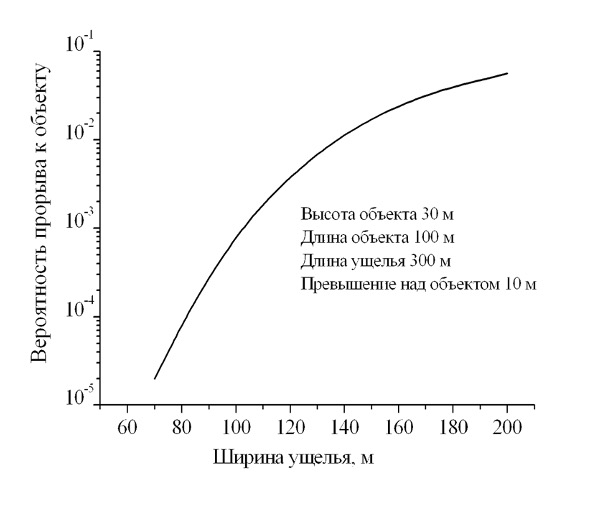
Fig. 1
Gorge width effect
Вероятность прорыва к объекту - Probability of the breakthrough to the facility
Ширина ущелья, м - Gorge width, m
Высота объекта 30 м - Facility height 30 m
Длина объекта 100 м - Facility length 100 m
Длина ущелья 300 м - Gorge length 300 m
Превышение над объектом 10 - Elevation over the facility 10 m
The deeper and narrower the gorge, the better its natural lightning protection for a structure located in the gorge. The statistical method developed in Russia allows evaluating the effect. Fig. 1 shows the effect of the gorge width evaluated using computer-aided calculations; it fully (with the elevation of 10 m) covers the protected facility 30 m high and 100 m long; the gorge continues for another 100 m at each side from the facility.
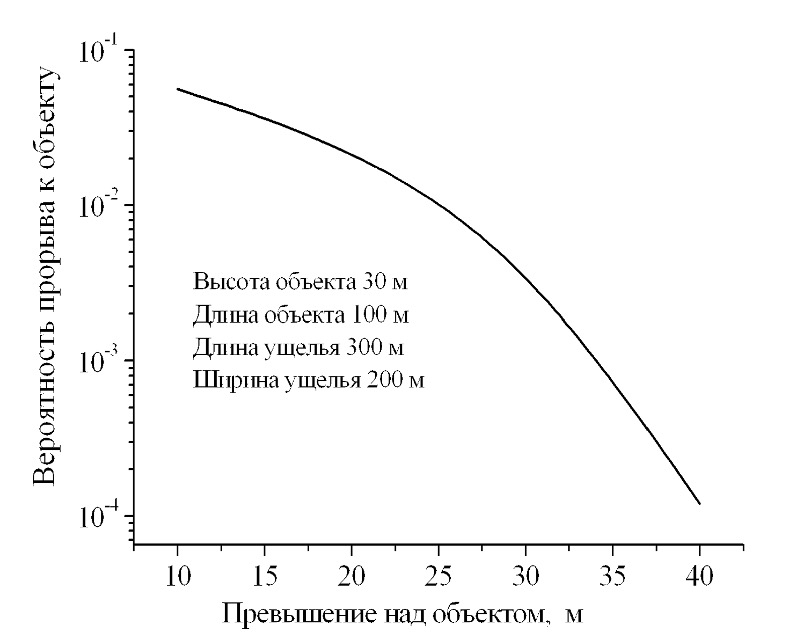
Fig. 2
Effect of gorge elevation over the protected facility
Вероятность прорыва к объекту - Probability of the breakthrough to the facility
Ширина ущелья 200 м - Gorge width 200 m
Высота объекта 30 м - Facility height 30 m
Длина объекта 100 м - Facility length 100 m
Длина ущелья 300 м - Gorge length 300 m
Превышение над объектом, м - Elevation over the facility, m
The results should not be surprising. The gorge edges actually function as a a natural duplicated wire lightning arrester installed with the distance between the overhead ground wires d and is characterized by the elevation over the protected facility to Δh = H – h (Fig. 3). Quantitatively, the proposed replacement scheme can be calculated using a PC, e.g., using the calculation software publicly available at the ZANDZ website.
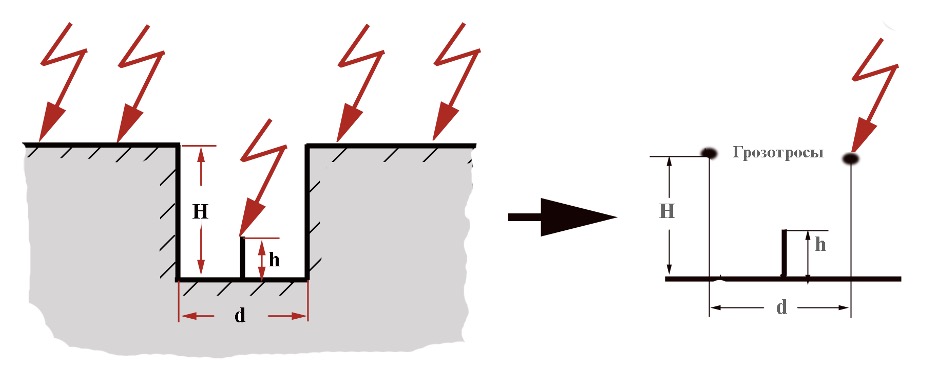
Fig. 3
To evaluate the efficiency of the protective effects of the gorge walls.
This problem becomes much more challenging when the protected facility partially rises over the gorge as shown in Fig. 4. Here, we cannot count on the accurate calculation. For inaccurate evaluations, the gorge may be replaced by
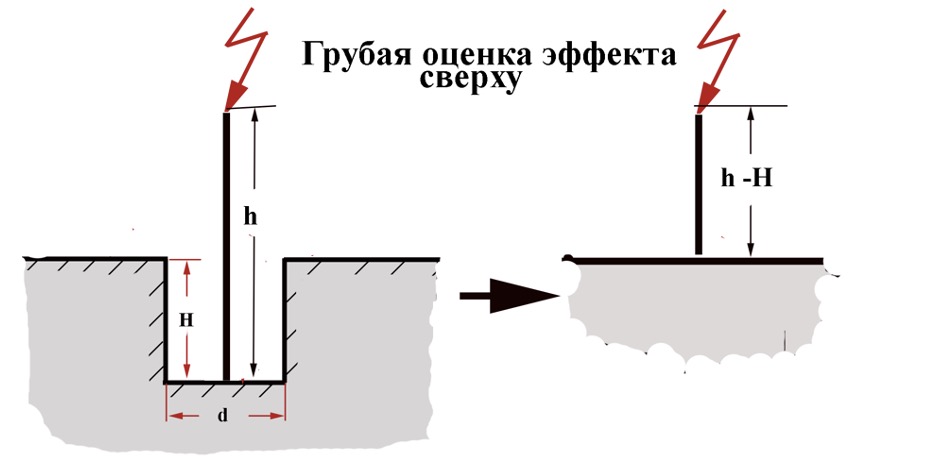
Fig. 4
Partial consideration of the gorge effect
Грубая оценка эффекта сверху - Rough evaluation of the effect from above
a flat ground surface whereon the protected facility of reduced height Δh = h –H is located. The evaluation seems to be simple although it is pretty practicable. It cannot lead to a significant error.
2. The effect of reduced air density.
In the USSR, this problem was willingly and actively being solved by our colleagues from Azerbaijan. We would like to see specific features of mountainous regions in their observations. Two aspects were the most attractive: reduced air density and vicinity of onground structures to the thunderclounds. There are some general reasons to suppose that lightnings in the mountain regions may be weaker than on a flat land.
For this reason, the specialists do not have any privileges in relation to the mountainous regions. We have to use a common current statistics collected by CIGRE so far. There are no reasonable grounds for any other options.
The air density effect on the lightning orientation is a special problem. The orientation is known to be performed by formation of opposed discharges from the lightning arrester and the facility protected by it. The discharge starts as the so-called ultracrown. To provide its start and development conditions, elevation above the sea level is very important. Typically, for industrial and civil structures, it does not exceed 3,000 m where the relative air density is close to 0.8. Calculation data in Fig. 5 show
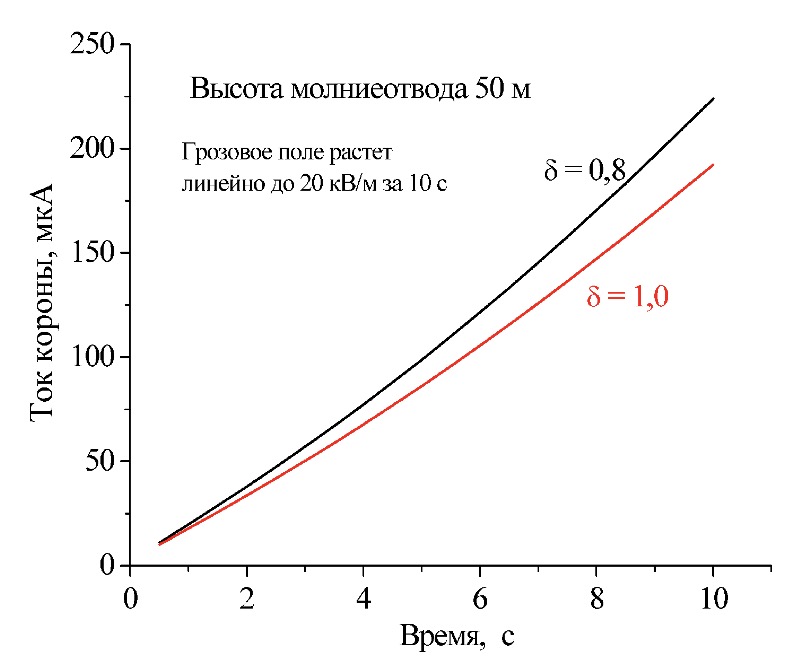
Fig. 5
Growth rate of a crown current over time in normal and reduced air density
Ток короны, мкА - Crown current, μA
Высота молниеотвода 50 м - Lightning arrester height 50 m
Грозовое поле растет линейно до 20 кВ/м за 10 с - Storm field grows in a linear fashion up to 20 kV/m for 10 sec
the growth rate of the crown discharge current from the 50 m structure in normal and reduced air density in a typical storm electric field. Current increase within 10% at the height is not significant for practical applications. The more so, distribution conditions of the opposed leader that completes the orientation process depend even less on the air density.
As a result, both downward lightning orientation height and the equivalent radius of lightning attraction at heights up to 3,000 m change significantly, and such changes are not meaningful for design calculations in lighting protection.
3. On high-rise structures
The terrain is great but onground structures also matter. You can also reach the thundercloud from the flat ground. Nowadays, skyscrapers are built not only in America. Their heights reach one km, which is one third of the distance to the lower charged cell of the thundercloud. Such buildings entail some consequences. Remember the Babylon tower. There are still various languages and dialects.
Today, readers don't like long articles insisting that brevity is the soul of wit. However, not all information can be described as short as "Veni, Vidi, Vici". I hope you can wait, otherwise it will be very difficult for you to understand the modern lightning protection science.
What changes occur along with the structure height?
First, it is the electric field. During the storm, this field E0 can hardly become more than 20 kV/m near the ground. To ionize air, the voltage at least 2 orders of magnitude more, about 3,000 kV/m, is required. It is generated by the electric charge electrostatically induced to a high-rise structure. To build a tower or a vertical rod having height h and radius r0 the electric field near the top, with high accuracy, is
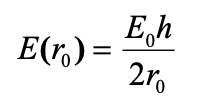
For a 200 m tower having radius of 1 m, it grows precisely 100 times. Note that the determining factor in the calculation is the height to radius ratio rather than the height alone. With the rod having height of 2 m and radius of 0.01 m, the field in the atmosphere will also grow 100-fold. Therefore, during the storm, any thin branch of a tree or a bush or even a sharp grass blade becomes a source of opposed ionization processes. They implement an electric charge to the atmosphere having the polarity opposed to the thundercloud lower cell charge. The charge covers the ground thereby reducing the storm electric field there. It is very important to understand how this happens.
The electric field reduces along with the distance from the structure's top. The measure of this reduction is the structure's top radius. This is well known even from the school's physics when the Coulomb's law is learnt. In fact, ionization is maintained only at the electrode top in the strongest field zone. The width of the zone is insignificant in the scale of the lightning discharge length being equal to several kilometers. The process happening there is called the crown discharge, more often ultra-crown sometimes streamerless crown (later you will understand how the latter term appeared).
Analyzing all specifics of the weak crown transformation to the power-intensive channel of the opposed leader is unreasonable, but one detail must be noted.
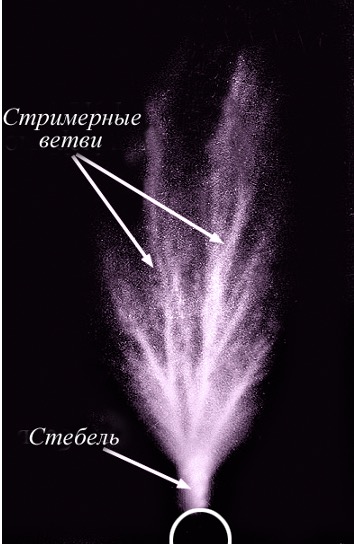
Fig. 6
Static photo of a streamer flash
Стимерные ветви - Streamer branches
Стебель - Stem
We are talking about the critical ultracrown current, at which its ionization zone cannot maintain at the electrode's top anymore. By tearing apart from the electrode, it distributes as a kind of an ionization wave, deeper to the atmosphere. For an observer, it looks like a flow that has broken a dam to flow along the ground as branching streams. The name streamer is based on the English word stream meaning a water flow (Fig. 6). By heating up to about 6,000 K, one of the streamer branches becomes a highly conductive channel of the opposed leader which can actually interfere with the lighting distribution process.
The calculation of the critical crown current turned out to be quite a surprise. Its value was very significant, at the level of 10-2 A. In the thundercloud field, this crown current on the flat ground cannot be reached even for the highest facilities, e.g. for the Ostankino TV tower. But adjacent downward lightnings come to help. The electrical charge of their channels, quickly reaching the ground, allows the critical crown current to be exceeded and the charge is converted to a more powerful streamer form. Fig. 7 schematically shows three development options.
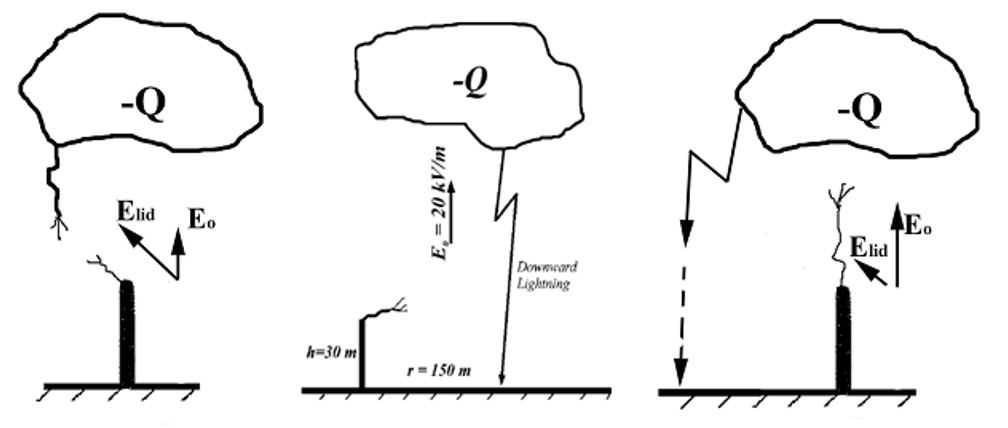
Fig. 7
Initiation of the opposed channel from the grounded electrode in the electric field of the downward lightning
In the first possible option, the started opposed channel is fully controlled by the electric field of the downward lightning and goes towards it. The channel contact leads to a strike of the downward lightning to an onground structure. The situation is typical for the structures of a relatively low height.
The second option can be considered "unsuccessful". The started opposed channel stops its growth as soon as the downward lightning strikes the ground and its electric field dissappears. The lightning hasn't got into the facility.
Finally, in the third option, the opposed channel could grow so long that it does not longer need the downward lightning field. After its strike to the ground, it continued its growth in the remaining thundercloud field. Being controlled by this field only, the opposed channel naturally advanced towards the storm cell of the cloud thus turning into the upward lightning channel. This situation is typical of high-rise structures having the height more than 200 m and located on the flat terrain.
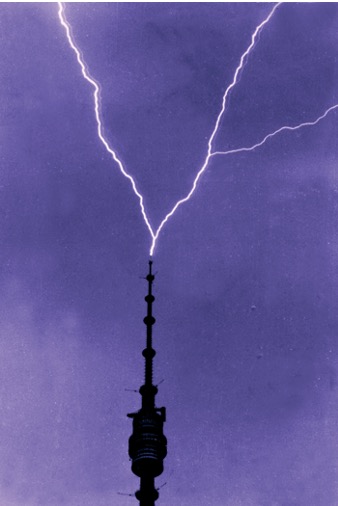
Fig. 8
Upward lightning from the top of the Ostankino TV tower
Opposed lightnings distinguish high-rise buildings from the ordinary ones in terms of their heights. They always start immediately from the top with the strongest electric field without displacing to the side surface by any marked distance (Fig. 8). The number of upward lightnings grows along with the structure's height. For example, on average, for the Ostankino TV tower, it reaches 27-30 per year. However, the number of downward lightnings almost never depends on the height of the high-rise building, and is close to 2 discharges per year on the flat terrain in Russia. These lightnings are not tied in any way to the top and may strike to the side surface far from it (Fig. 9).
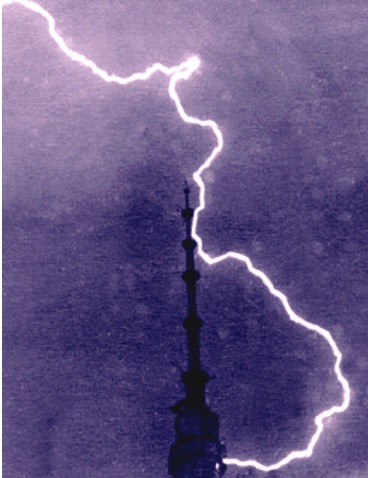
Fig. 9
Downward lightning has missed by 202 m
Therefore, if required, we have to protect the side surfaces of the high-rise buildings.
Note that mechanical and heat effects of the lightning of any type are not dangerous for the high-rise buildings. They can only damage small antenna systems or sensors but they cannot damage the structural strength of the building. Electromagnetic interference is a whole new ball game. Here, upward lightnings may be no less dangerous than downward ones.
4. High-rise structures in mountainous areas
My own experience demonstrates that mountains are very close to thunderclouds. When writing the article, I memorize my hair standing up and unpleasant sparks felt when contacting a metal surface. Electrostatic interference in mountains will be remembered for a long time. They significantly affect the opposed discharge development. This is confirmed by the computer-aided calculations of the crown current as provided in Fig. 10. The calculation assumes that the storm cell charge provides, at the ground surface,
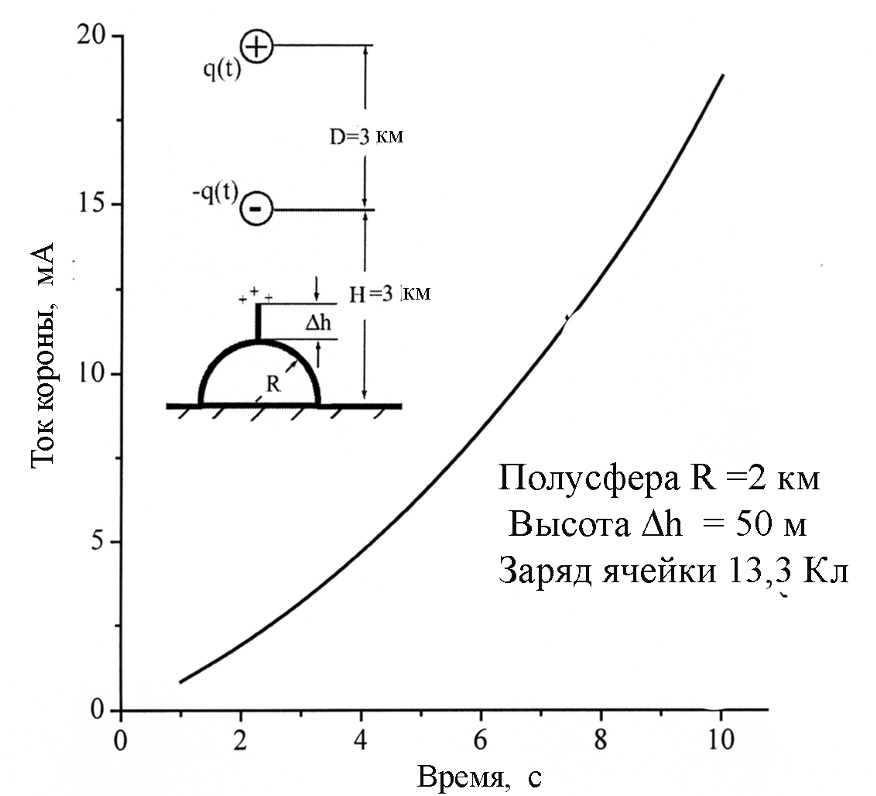
Fig. 10
Opposed crown discharge current growth rate from the 50 m rod electrode at the hemisphere elevation top having the radius of 2 km. The storm cell with the charge of -13.3 C at the height of 3 km
Ток короны, мА - Crown current, mA
Время, с - Time, sec
Полусфера R = 2 км - Hemisphere R = 2 km
Высота Δh = 50 м - Height Δh = 50 m
Заряд ячейки 13,3 Кл - Cell charge 13.3 C
the typical electric field of 20 kV/m. Due to being significantly closer to the thundercloud, the field at the elevation top is increased to 270 kV/m, and it is even stronger at the rod electrode's top.
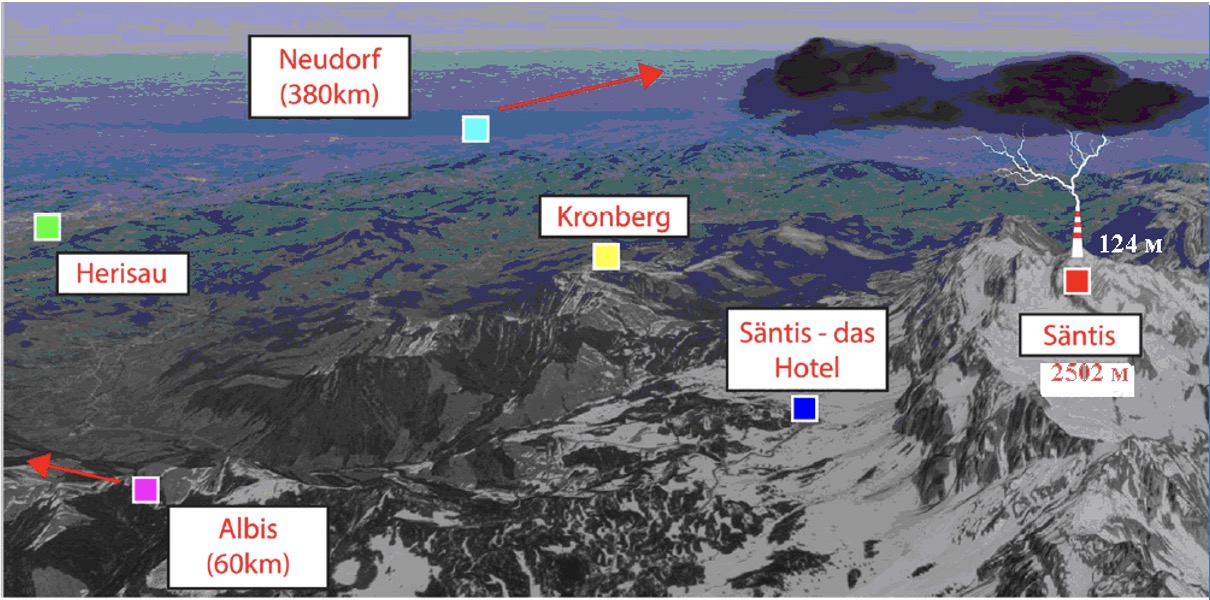
Fig. 11
A scheme of the mountain group shown in Fig. 11 confirms this. The Santis Mount located at 2,500 m above the sea level is used as a field laboratory for oscillographic records of the lightning current. As a lightning rod, a rod 124 m high is installed at the mountain top. The average frequency of storm discharges to the rod reaches 100 during a storm season here! There's nothing like this can happen on a flat ground.
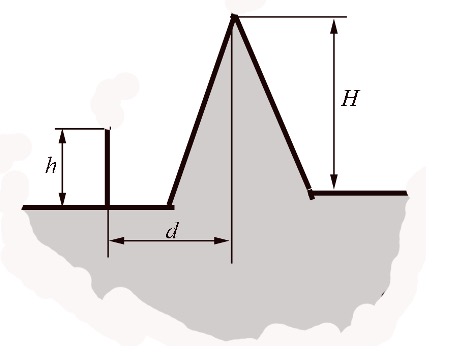
Fig. 12
The terrain is excited only from one side of the facility
I would love to end the article optimistically. But there are no reasons for it yet. And the point is more than the number of considered terrain options. Based on the experience of simplifying particular situations provided herein, the reader can cope with any new option, e.g. consider a one-sided terrain excitement similarly to the one shown in Fig. 12. Here, the facility is covered by a hill that operates as a single natural lightning arrester This protection cannot be considered reliable enough, although the effect is clearly visible. It can be evaluated by changing the hill with a rod lightning arrester having the height H at the distance d. from the facility. Moreover, a more experienced designer can replace the hill with a triangle pyramid and use it in the free ZANDZ software as a natural lightning arrester.
The point is about scholars rather than designers. For now, they could not collect the trustworthy statistics of lightning currents in mountainous areas, study the specific features of the protective action of lightning arresters, and find the method of interaction of elevations of various forms with the thundercloud field. There is much work ahead and it cannot be said that it is simple.

